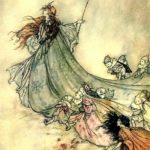The Sweet Far Thing
The Gemma Doyle Trilogy
By Libba Bray
Gemma Doyle drove me up the wall with her indecisiveness in The Sweet Far Thing. This book is over 800 pages. It didn’t need to be. There are a fair few subplots that simply didn’t need to be there, and Gemma spends an ungodly amount of time doing the “Will I? Won’t I? Should I?” in regard to what to do with the magic in the realms. As an editor, I wanted to get my hands on the author and help them tighten up their manuscript.

Another thing that bothered me somewhat in The Sweet Far Thing was how Pippa and Felicity’s relationship was handled. No, it didn’t particularly feel like an unnatural progression, but I also got the distinct feeling that the girls’ relationship was forced into the narrative through flashback and an outside character going, “Oh.” I have a few reasons I think this may have actually been the case. And these girls deserved more than being an afterthought.
1) Felicity didn’t want to marry. Okay, fine, but you don’t have to be gay to not want a marriage and desire to live your life freely.
2) Felicity was always freer with her body and more confident in herself, but her desire to wear trousers and more avant-garde fashions of the late 1890s was something completely new in The Sweet Far Thing, and it mostly came off as part of Felicity’s admittedly rebellious nature instead of a true want or need to be happy and herself.
3) Pippa very specifically dreamed of a knight in shining armor to marry her and sweep her away.
4) Felicity has been with at least one man already. Yes, she could easily be bisexual (or any other sexuality attracted to more than one sex) but because Felicity and Pippa show nothing anywhere close to the type of relationship Felicity has shared with others, their kiss feels false. Not like a “forbidden love” and more like the afterthought it is by the author.
The ending is . . . something else. I didn’t dislike it, but Gemma suddenly speaking up for herself and her entire family simply allowing it doesn’t feel genuine. I wanted her to fight for what she wanted. She’d done her fight and growing up in the realms—more or less—and now it’s time for her to go back to her real life and fight there, too, but with confidence this time. Felicity and Ann both find a path toward the lives they want, so their stories are neatly tied with a bow as well.

The conclusion in the realms was about what I expected; Bray wasn’t showing signs of letting Kartik and Gemma be happy together, so I figured she’d off one of them. I found her method of doing so a little odd, but not unreasonable given the genre. However, the moment Kartik and Gemma share in the realms is heart-wrenchingly beautiful and very well written. It felt like a last bastion of hope before the coming war, swimming with possibility without the interference of fate. Alas.
Which leads me to the last thing: I still enjoy Libba Bray’s writing style, and I’d like to see more of it in the future. Did The Sweet Far Thing need more work before hitting the shelves? Yes, I believe it did. Was this a terrible book that should never see the light of day? No. Is this book one I’m okay with shelving or handing off to the next reader? Yes.
~ Anna
(Entry 24)
















